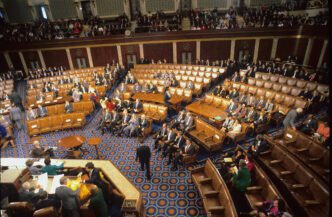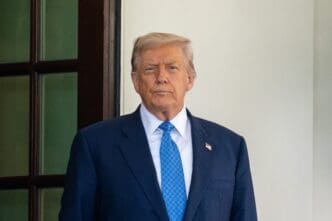KEY POINTS
- American officials are in a last-minute scramble to finalize details for the surprise summit between President Donald Trump and Russian President Vladimir Putin, which is now just four days away.
- The meeting, scheduled for August 15 in Alaska, is the first between the two leaders since 2018 and is a dramatic attempt by President Trump to broker a peace deal to end the war in Ukraine.
- The summit is being held following a Russian peace proposal that would have Ukraine cede significant territory, an offer that has been met with skepticism from European officials and outright rejection from Ukrainian President Volodymyr Zelenskyy.
WASHINGTON – American officials are engaged in a frantic, last-minute scramble to finalize the logistical and geopolitical details of President Donald Trump’s surprise summit with Russian President Vladimir Putin, with the momentous sit-down in Alaska now just four days away.
As of Monday, key questions—including the precise venue for the meeting and, most critically, whether Ukrainian President Volodymyr Zelensky will be invited—remain unsettled. The uncertainty surrounding the summit as the week begins underscores the extraordinary and high-stakes diplomatic gambit the president has embarked upon. After months of being disillusioned by the Russian leader’s duplicity, Trump is now diving headfirst into the biggest test yet of his long-held faith in the power of face-to-face diplomacy to end the war in Ukraine.
The hastily arranged meeting, which the president announced on Friday, was organized with extraordinary speed following a new peace proposal from Putin. The pressure is now on the administration to not only manage the complex logistics of a presidential summit with an adversary but also to navigate the deep anxieties of its European and Ukrainian allies, who fear a deal could be struck over their heads.
“Next Friday will be important, because it will be about testing Putin, how serious he is on bringing this terrible war to an end,” NATO Secretary General Mark Rutte, who has forged a close partnership with Trump, said Sunday on ABC.
The Zelensky Question Looms Large
One of the most significant questions hanging over the preparations is whether President Zelensky will be included in the Alaska summit. The White House has not ruled out the possibility but has made it clear that its immediate priority is organizing the one-on-one meeting between Trump and Putin.
“If he thinks that that is the best scenario to invite Zelensky, then he will do that,” the U.S. ambassador to NATO said on Sunday. “The meeting’s happening on Friday. There’s time to make that decision.”
Ukrainian officials have made it clear that Zelensky is prepared to travel to Alaska at a moment’s notice if invited by Trump, but they also acknowledge that much will depend on how the initial Trump-Putin meeting unfolds.
“We have shown that he is ready to be anywhere to advance the agenda of peace. So, if needed, President Zelensky, of course, will be present at the meetings,” the Ukrainian ambassador to the U.S. said on CBS. “We have been very open about it, but let’s see how this will go.”
European Allies Await Details and Press Red Lines
European leaders have been anxiously awaiting more details from the United States about the exact nature of Putin’s proposal, which was presented to Trump’s envoy, Steve Witkoff, in Moscow last week. As they understand it, the plan would give Moscow control of Ukraine’s entire eastern Donbas region, which Russia partially occupies, in exchange for a ceasefire. The fate of other partially occupied regions, like Kherson and Zaporizhzhia, remains unclear, as does the status of future U.S. security guarantees for Ukraine.
Over the weekend, the administration dispatched Vice President JD Vance to meet with national security advisers from major European nations at the British foreign secretary’s stately country home in an effort to explain Trump’s objectives and hear out their concerns.
Atop their list of demands was the importance of implanting a ceasefire before any further ideas are discussed—a mandate Putin has repeatedly rejected in the past. The Europeans also pressed for reciprocity in any land concessions, positing that if Ukraine cedes territory in the Donbas, Russia must also pull back its occupation from other parts of Ukraine.
Perhaps most urgently, however, the leaders insisted that Ukraine itself must be directly involved in any discussions about its future. A U.S. official said the meeting yielded “significant progress,” and two European officials said they felt Vance was receptive to their viewpoints.
German Chancellor Friedrich Merz, who said he planned to speak with Trump on Sunday, reiterated the unified European position. “We hope and assume that the government of Ukraine, that President Zelensky, will be involved in this meeting,” Merz said in an interview with German public broadcaster ARD. “We cannot accept that territorial issues between Russia and America are discussed or even decided over the heads of Europeans and Ukrainians.”
President Trump, meanwhile, spent much of the weekend hearing from his own allies about the importance of including Ukraine. After playing a round of golf with the president on Saturday, Senator Lindsey Graham of South Carolina said he, too, wanted Ukraine to be part of the peace talks.
“I do hope that Zelensky can be part of the process. I’ll leave that up to the White House,” Graham said on NBC. “But I have every confidence in the world that the president is going to go to meet Putin from a position of strength, that he’s going to look out for Europe and Ukrainian needs to end this war honorably.”
Before the Alaska summit was announced, Vice President Vance acknowledged that any potential peace deal would likely be imperfect. “It’s not going to make anybody super happy,” he said in an interview with Fox News. “Both the Russians and the Ukrainians, probably, at the end of the day, are going to be unhappy with it. But I don’t think you can actually sit down and have this negotiation absent the leadership of Donald J. Trump.”








